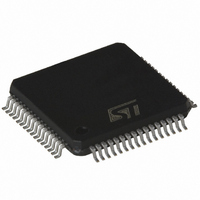L6713A STMicroelectronics, L6713A Datasheet - Page 9

L6713A
Manufacturer Part Number
L6713A
Description
IC CTRLR 2/3PH W/DRIVERS 64-TQFP
Manufacturer
STMicroelectronics
Datasheet
1.L6713ATR.pdf
(64 pages)
Specifications of L6713A
Applications
Controller, Intel VR10, VR11, AMD CPU
Voltage - Input
12V
Number Of Outputs
3
Voltage - Output
0.3 ~ 1.6 V
Operating Temperature
0°C ~ 70°C
Mounting Type
Surface Mount
Package / Case
64-TQFP Exposed Pad, 64-eTQFP, 64-HTQFP, 64-VQFP
Output Current
2 A
Mounting Style
SMD/SMT
Maximum Operating Temperature
+ 125 C
Minimum Operating Temperature
0 C
Lead Free Status / RoHS Status
Lead free / RoHS Compliant
Available stocks
Company
Part Number
Manufacturer
Quantity
Price
L6713A
Table 2.
N°
30
31
32
33
34
35
36
37
38
39
VID7/DVID
SS/ LTBG/
VID_SEL
OCSET
FAULT
CS1+
OSC/
CS1-
AMD
VID6
OVP
FBG
Pin
Pin description (continued)
Channel 1 current sense positive input.
Connect through an R-C filter to the phase-side of the channel 1 inductor.
See “Layout guidelines” Section
Channel 1 current sense negative input.
Connect through a Rg resistor to the output-side of the channel 1 inductor.
See “Layout guidelines” Section
Soft-start oscillator, LTB gain and AMD selection pin.
It allows selecting between INTEL DACs and AMD DAC.
Short to SGND to select AMD DAC otherwise INTEL mode is selected.
When INTEL mode is selected trough this pin it is possible to select the soft-
start time and also the gain of LTB Technology™.
See “Load transient boost technologyTM” Section
Over voltage programming pin. Internally pulled up by 12.5 µA (typ) to 5 V.
Leave floating to use built-in protection thresholds as reported into
Connect to SGND through a R
the OVP threshold to a fixed voltage according to the R
See “Over voltage and programmable OVP” Section
Intel mode. Internally pulled up by 12.5 µA (typ) to 5 V.
It allows selecting between VR10 (short to SGND,
See Table
AMD mode. Not applicable. Needs to be shorted to SGND.
Over current set pin.
Connect to SGND through a R
also a C
See “Over current protection” Section
Connect to the negative side of the load to perform remote sense.
See “Layout guidelines” Section
Oscillator pin.
It allows programming the switching frequency F
equivalent switching frequency at the load side results in being multiplied by the
phase number N.
Frequency is programmed according to the resistor connected from the pin vs.
SGND or VCC with a gain of 8 kHz/µA (see relevant section for details).
Leaving the pin floating programs a switching frequency of 200kHz per phase.
The pin is forced high (5 V) to signal an OVP FAULT: to recover from this
condition, cycle VCC or the OUTEN pin.
VID7 - Intel mode. See VID5 to VID0 section.
DVID - AMD mode. DVID output.
CMOS output pulled high when the controller is performing a D-VID transition
(with 32 clock cycle delay after the transition has finished).
transitions” Section
Intel mode. See VID5 to VID0 section.
AMD mode. Not applicable. Needs to be shorted to SGND.
OCSET
7) DACs.
capacitor to set a delay for the OCP intervention.
Section for details.
See “Configuring the device” Section
OCSET
OVP
for proper layout of this connection.
for proper layout of this connection.
for proper layout of this connection.
Function
resistor and filter with 100 pF (max) to set
resistor to set the OCP threshold. Connect
for details.
See “Oscillator” Section
SW
See “Soft-start”
for details.
Table
of each channel: the
Section for details.
OVP
8) or VR11 (floating,
for details.
See “Dynamic VID
resistor.
for details.
Pin settings
Section”
Table
12.
and
9/64













